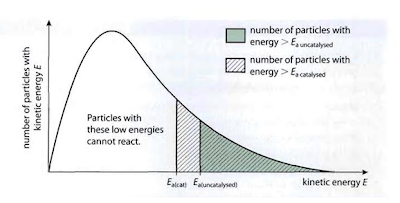The alkanes were originally called "paraffins", meaning "little reactivity". They can be found in crude oil and natural gas and they are also used as fuels and the starting materials for making a huge variety of organic compounds.
A. Physical Properties
a). Boiling Points
a). Boiling Points
· What are the boiling points of methane, pentane and hexane?
Methane | -161 ˚C |
Pentane | 36 ˚C |
Hexane | 50 ˚C |
· Which is the first straight chain alkane to be a liquid at room temperature and pressure? –Pentane
· In terms of intermolecular forces, explain why the boiling points of the alkanes increase with increasing molecular mass.
Alkanes have Van der Waal's forces between them. So with the increasing molecular mass, there is also increasing surface area of straight chain alkanes, resulting in a stronger attraction between alkane molecules. This means more energy is required to break these bonds for a change of state.
· What is the effect of branching on the boiling points of the alkanes?
Branching tends to lower the boiling point since it decreases the surface area.
b). Solubility In Water
· Does the hexane dissolve in water? In terms of intermolecular forces, explain why the two liquids behave in this way.
The hexane is immiscible and does not dissolve in water. This is because there is a difference of polarity between the two liquids. Polar solvents dissolve polar compounds best and non-polar solvents dissolve non-polar compounds. While hexane is non-polar, water is polar - so the two liquids do not mix.
· Is hexane more or less dense than water? How do you know?
Hexane is less dense because the layer of hexane is on top of the water.
B. Chemical Properties
a). Reaction With Some Common Reagents
· Does hexane appear to react with any of these substances?
Having done the test, this shows that Hexane reacts with none of the substances, concluding that they all form immiscible layers.
· The alkanes were once more commonly called 'paraffins'. Why was this name used?
Maybe the alkanes are typically used as fuels.
· In which substance is bromine more soluble - hexane or water? Why?
Bromine is more soluble in hexane since they are both non-polar and will dissolve into each other.
· In which substance is potassium manganate (VII) more soluble - hexane or water? Why?
Potassium manganate is more soluble in water as they are both polar and will dissolve into each other.
c). Combustion Of Alkanes
· Write a balanced equation for the reaction that occurs.
CH4 + 2 O2 ----------> CO2 + 2 H2O
· Write a balanced equation for the reaction that occurs.
2 C6H14 + 19 O2 ----------> 12 CO2 + 14 H2O
· Which burns with the sootier flame? Explain why hexane should burn with a sootier flame.
Hexane - because it has a higher percentage of carbon than methane.
· Can the wax be easily ignited?
No.
· Why is the wax harder to ignite than methane even though they both contain alkanes?
Paraffin is a much longer alkane chain and is therefore harder to ignite.
· Why does a candle have a wick?
The wick creates a mechanism called capillary action, in which the wick draws the molten wax to the flame, transported the liquid wax as fuel. When the fuel reaches the flame it then vaporizes and burns.
d). Cracking Paraffin Oil
· Why are the first bubbles of gas not collected?
These first bubbles are displaced air which was in the delivery tube before the experiment began.
· Why is the porcelain heated strongly before the oil is warmed?
The porcelain acts as a catalyst and needs to be heated strongly before the oil vaporizes and makes contact with it. If the catalyst pieces are colder than the boiling point of the paraffin, the oil will condense on them and not react.
· Why is the porcelain broken into small pieces?
To create a greater surface area.
· Add a few drops of bromine water to one of the test tubes containing gas, quickly stopper and shake. What happens? Write an equation for the reaction that takes place.
The bromine water is decolorized.
C2H4 + Br2 + H2O ----------> C2H4BrOH + HBr
· Try to light the gas in one of the the test tubes with a lighted splint. What happens? Write an equation for the reaction that occurs.
Water vapour is readily produced.
C2H4 + 3 O2 ----------> 2 CO2 + 2 H2O
· Name the type of reaction carried out in the main experiment. Why are reactions of this sort important in the petrochemical industry?
Long chain alkanes are be broken down to shorter chain alkanes and alkenes which are much more useful to the petrochemical industry.
· Given that the molecular formula of paraffin oil is C20H42, suggest an equation for the reaction that has occurred in this experiment.
C20H42 ----------> C8H18 + C8H16 + C4H8



























